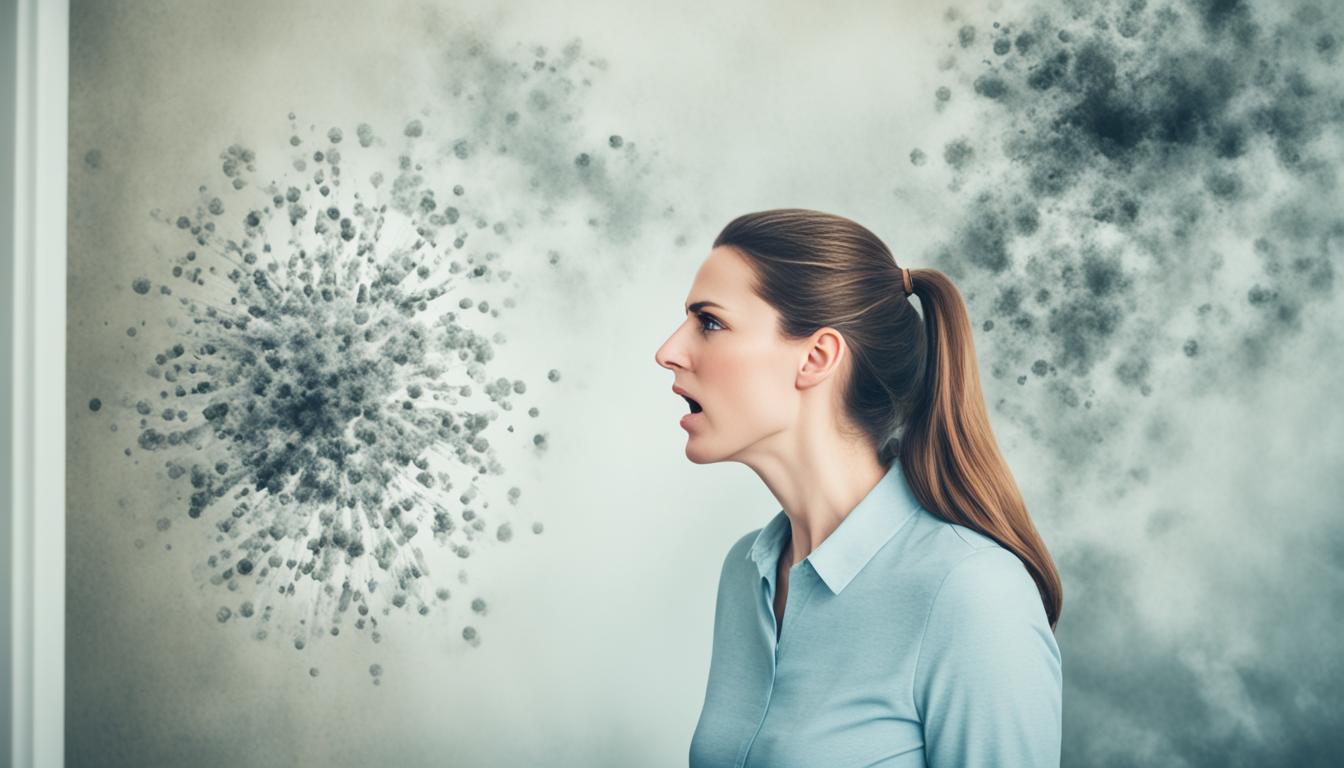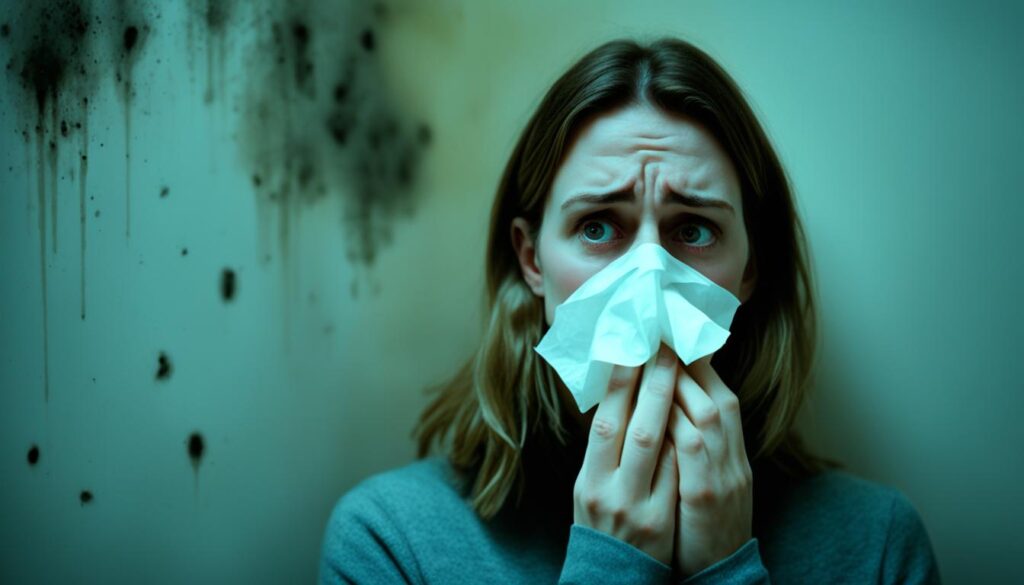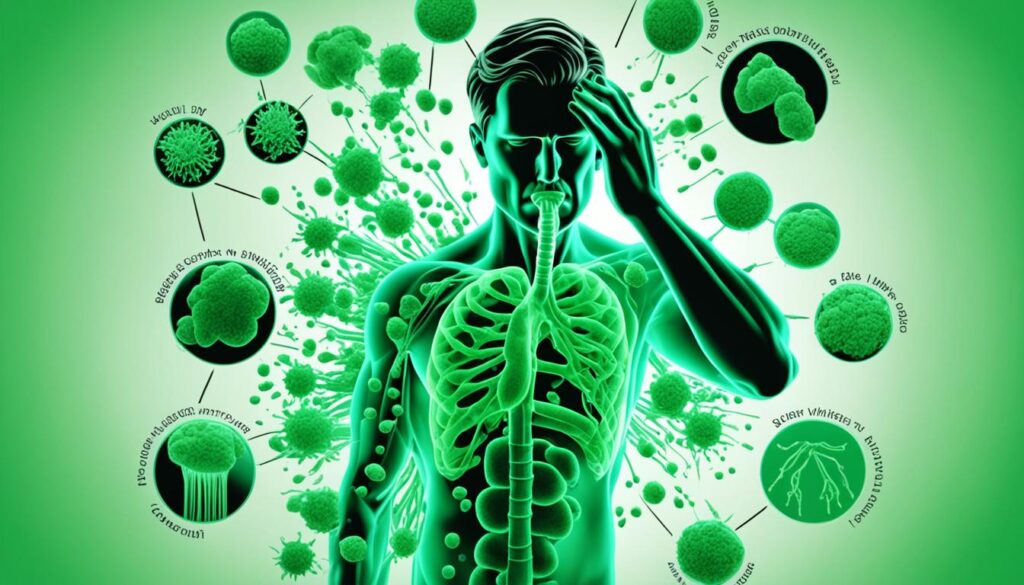
Symptoms of Mold Exposure: Identify Risks & Signs
Mold exposure can have detrimental effects on our health. It is crucial to understand the symptoms associated with mold exposure to identify the risks involved and take appropriate action. Whether you suspect your home or workplace has mold or you have experienced unexplained health issues, recognizing the signs can help you address the problem promptly.
In this section, we will explore the range of symptoms that can occur when individuals are exposed to mold. By familiarizing yourself with these indicators, you can safeguard your health and make informed decisions regarding mold assessments and remediation services.
Key Takeaways:
- Recognizing symptoms of mold exposure helps identify potential health risks.
- Common symptoms of mold exposure can range from mild to severe and affect different parts of the body.
- Understanding the health risks associated with mold exposure is crucial for preventive measures.
- Taking necessary precautions and seeking professional assistance can protect your well-being.
- Fix Mold Miami provides mold assessments and remediation services to aid you in dealing with mold-related issues.
Common Symptoms of Mold Exposure
When individuals are exposed to mold, they can experience a variety of symptoms that can range from mild to severe. It’s important to recognize these signs as they can be indicative of potential mold-related health issues. Here, we will discuss the most common symptoms associated with mold exposure and how they can affect different parts of the body.
Allergic Reactions
One of the most common symptoms of mold exposure is allergic reactions. When exposed to mold spores, individuals with allergies may experience symptoms such as:
- Nasal congestion and runny nose
- Sneezing and itching of the nose, eyes, or throat
- Coughing
- Watery or red eyes
Respiratory Issues
Mold exposure can also lead to respiratory problems, particularly in individuals with underlying respiratory conditions or weakened immune systems. Some common respiratory symptoms of mold exposure include:
- Chest tightness
- Shortness of breath
- Wheezing and coughing
- Difficulty breathing
Skin Irritation
Exposure to mold can cause skin irritation and allergic reactions. Symptoms of mold-related skin issues may include:
- Rashes
- Itchy skin
- Redness and inflammation
- Dry, scaly skin
Other Symptoms
Aside from allergic reactions, respiratory problems, and skin irritation, mold exposure can also manifest in other ways. Some additional common symptoms include:
- Fatigue and weakness
- Headaches
- Dizziness
- Brain fog and difficulty concentrating
It’s important to note that the severity and type of symptoms can vary depending on individual sensitivity, duration and intensity of mold exposure, and the specific type of mold present. If you suspect mold exposure and are experiencing any of these symptoms, it’s advisable to consult with a healthcare professional for proper diagnosis and appropriate treatment.

| Symptom | Description |
|---|---|
| Allergic Reactions | Manifests as nasal congestion, sneezing, itching, and watery or red eyes |
| Respiratory Issues | Includes chest tightness, shortness of breath, wheezing, and coughing |
| Skin Irritation | Characterized by rashes, itchy skin, redness, and dryness |
| Other Symptoms | May involve fatigue, headaches, dizziness, and difficulty concentrating |
Health Risks of Mold Exposure
Exposure to mold can have significant health risks that individuals need to be aware of. Mold has been linked to various health problems, including respiratory issues, allergic reactions, and even neurological symptoms.
Respiratory Issues: Mold spores can be inhaled and irritate the respiratory system, leading to respiratory problems such as coughing, wheezing, and shortness of breath. Individuals with pre-existing respiratory conditions like asthma may experience worsened symptoms when exposed to mold.
Allergic Reactions: Many people are allergic to mold, and exposure can trigger allergic reactions. Common symptoms include sneezing, itching, watery eyes, and skin rashes. In individuals with severe mold allergies, exposure can even lead to anaphylaxis, a potentially life-threatening allergic reaction.
Neurological Symptoms: Some studies suggest a possible link between mold exposure and neurological symptoms, although more research is needed to establish a clear causal relationship. However, there have been reports of individuals experiencing headaches, memory problems, dizziness, and difficulty concentrating after exposure to mold.
“Exposure to mold can have serious health consequences, particularly for individuals with underlying respiratory conditions or mold allergies. It is crucial to take the necessary precautions to limit exposure and seek professional assistance for mold remediation.”
Health Risks of Mold Exposure
| Health Risks | Description |
|---|---|
| Respiratory Issues | Mold spores can irritate the respiratory system, leading to coughing, wheezing, and shortness of breath. |
| Allergic Reactions | Exposure to mold can trigger allergic reactions, causing symptoms like sneezing, itching, and skin rashes. |
| Neurological Symptoms | Mold exposure has been associated with headaches, memory problems, dizziness, and difficulty concentrating. |

Conclusion
In conclusion, understanding the symptoms of mold exposure is essential for identifying potential health risks. Recognizing the common signs, such as respiratory issues, allergic reactions, and neurological symptoms, can help individuals take proactive measures to prevent further exposure.
If you suspect mold in your home or workplace, it is crucial to seek professional assistance for mold assessments and remediation services. Companies like Fix Mold Miami specialize in providing comprehensive solutions to ensure a safe and healthy environment.
Remember, protecting your health should always be a top priority when dealing with mold-related issues. By taking the necessary precautions and seeking professional help, you can mitigate the potential health risks associated with mold exposure and safeguard your well-being.




